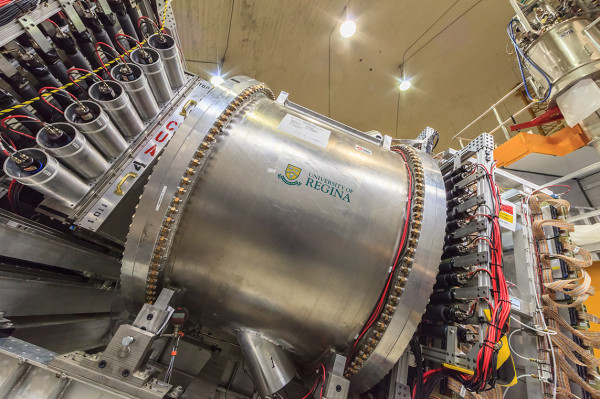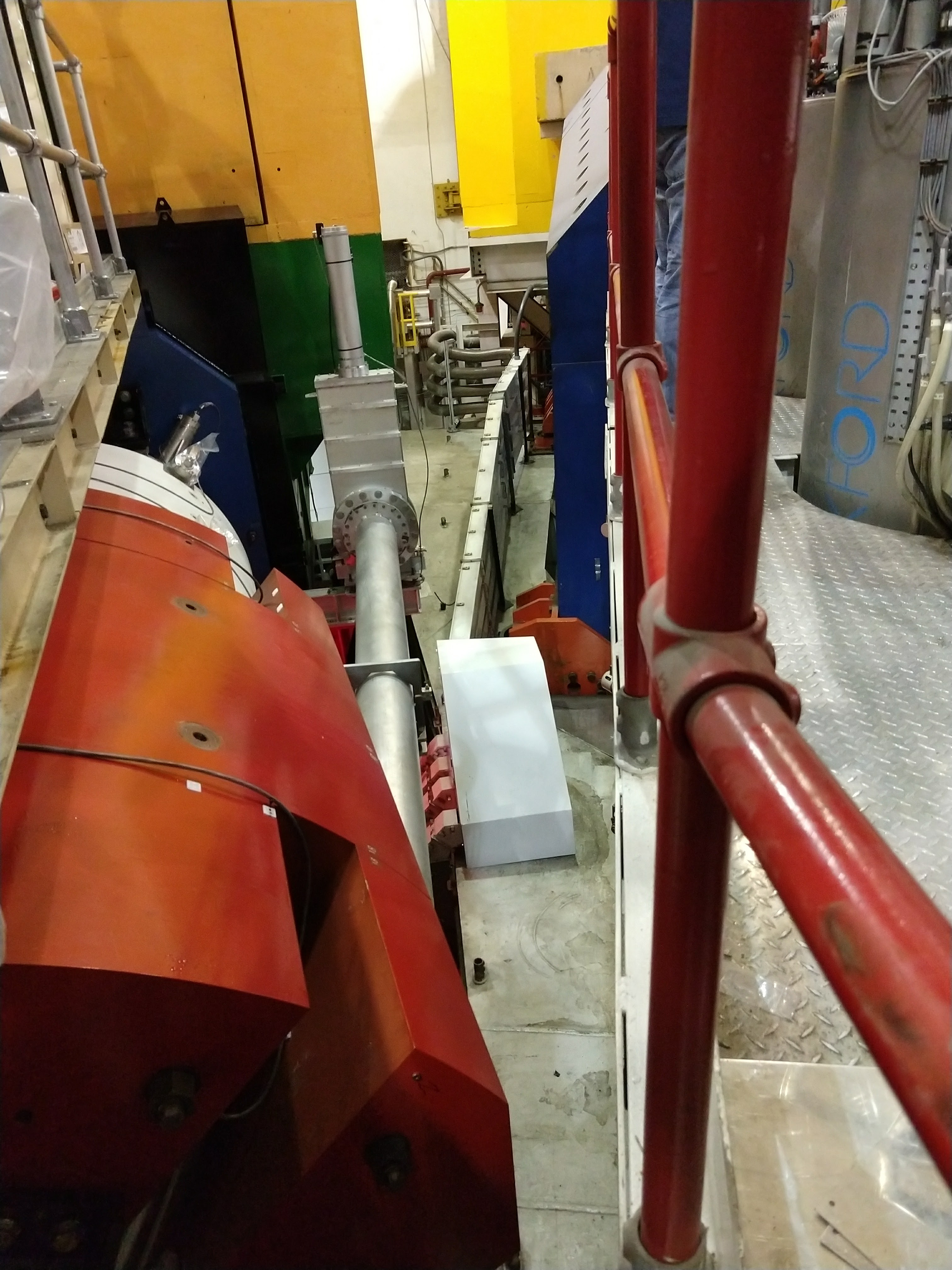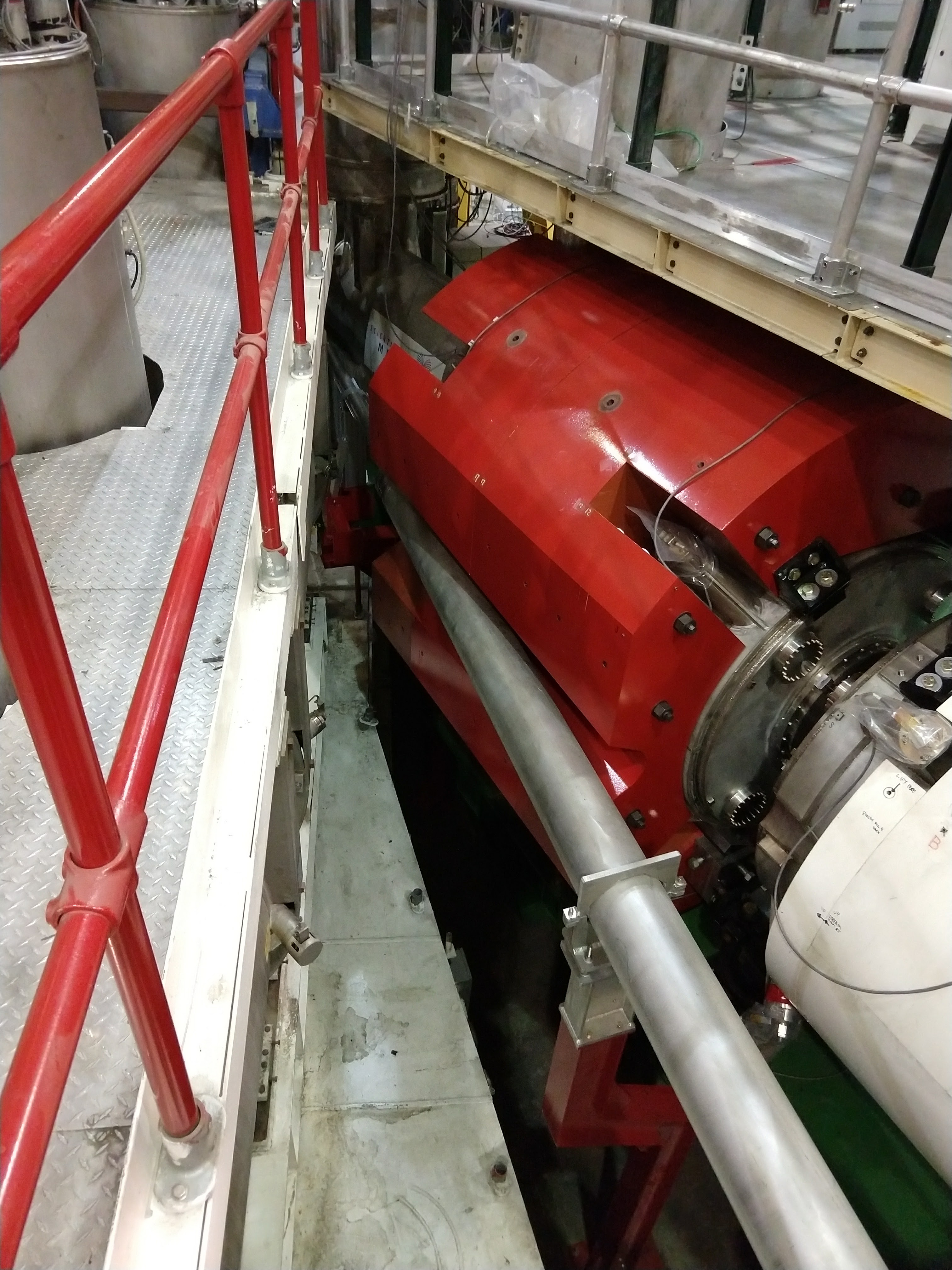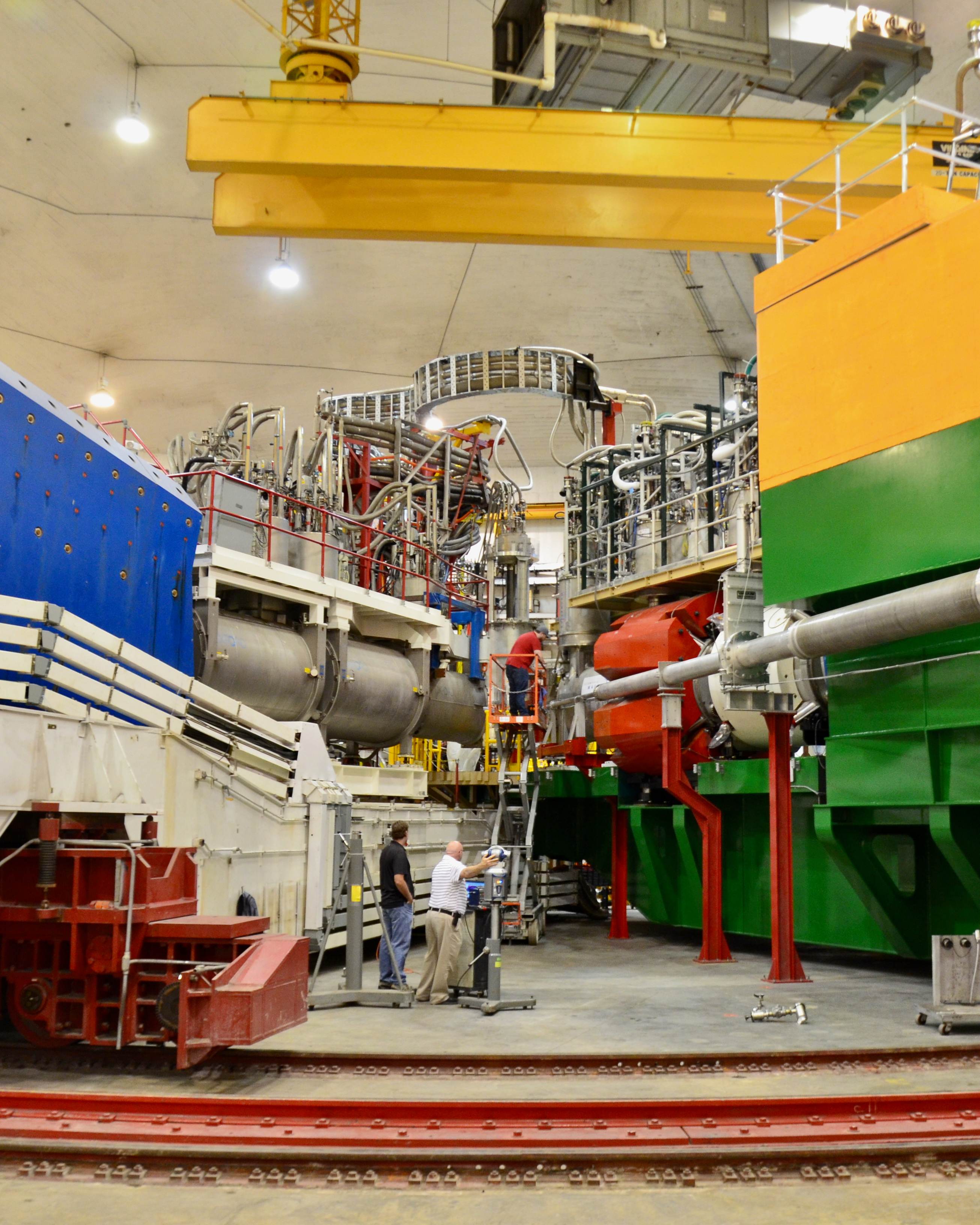These images show placement of the Super High Momentum Spectrometer (SHMS) and High Momentum Spectrometer (HMS) detector systems as nuclear physicists prepare for experiments. The SHMS has red, white and blue magnets with a muted yellow and green detector hut. The HMS has bare metal and blue magnets with a bright yellow detector hut. This experiment brought the SHMS the closest it has ever been to the beam line (Grey pipe seen nestled inside the red magnet on the SHMS). A view of the hall with the HMS set at a wider angle is also shown for comparison.
A device cozies up to the beamline to study the common pion
NEWPORT NEWS, VA – Tanja Horn likens standing near the Pion L/T experiment to walking through an alley between city skyscrapers.
“It’s really narrow,” said Horn. She is a co-spokesperson for the Pion L/T experiment and a professor of physics at The Catholic University of America who has a joint appointment with the U.S. Department of Energy’s Thomas Jefferson National Accelerator Facility. “It’s a little claustrophobic.”
This experimental alley, which is created by giant machines and magnets used to study a tiny particle, narrows down to a point at its end. And this point is a huge achievement for Jefferson Lab.
Getting to the point
The Pion L/T experiment, which is housed in Jefferson Lab’s Experimental Hall C, seeks to better understand the structure of the pion, a subatomic particle consisting of a quark-antiquark pair. Studying pion structure could help physicists get a better grasp on the origin of the mass of ordinary matter.
Ordinary matter is made up of atoms, and these atoms are made up of fundamental particles that don’t have a lot of mass themselves. Physicists want to know how these relatively light particles give rise to the mass of all ordinary matter.
“What we’re hoping is that from the data there will be a better understanding of the structure of the pion and hopefully then also a better grasp of this much more complicated question underneath, which is really central to the purpose of Jefferson Lab,” said Garth Huber, co-spokesperson for the Pion L/T experiment and a professor of physics at the University of Regina in Canada.
Jefferson Lab is home to the Continuous Electron Beam Accelerator Facility (CEBAF), a DOE Office of Science user facility. To address these questions, Pion L/T shoots an electron beam from CEBAF at a liquid hydrogen target, producing pions. A device called a spectrometer detects these pions.
“What is rather difficult to achieve is that we must detect the particles at a very small angle from the beam line, 5.5 degrees,” Huber said. “If we were detecting at a larger angle, we would not be sensitive to the part of pion structure that we need.”
Getting down to a 5.5-degree angle between the beam pipe delivering electrons and the spectrometer also ensures the measurements are precise.
While CEBAF has previously taken measurements at an angle this small, those were with spectrometers stuck at one, fixed angle. However, Pion L/T needs to collect data at larger angles, as well.
During the 12 GeV CEBAF Upgrade project, Jefferson Lab built a new spectrometer, the Super High Momentum Spectrometer (SHMS), which was designed to be capable of a 5.5 angle from its beam line but can also quickly change angles for different measurements.
Since its 2017 installation in Hall C, the SHMS has been used by a few other experiments that attempted to reach a 5.5-degree angle.
“We just never quite got there,” said Dave Gaskell, co-spokesperson for the Pion L/T experiment and a staff scientist at Jefferson Lab. “The difference this time was that the Hall C head engineer Steven Lassiter worked closely with hall technicians to pre-stage everything months ahead of time. They went the extra mile to make sure we could get to this small angle.”
Lassiter’s team had to carefully assemble the gigantic puzzle that is the Pion L/T experiment.
“The engineering team was responsible for the design, fabrication and installation of the SHMS and the various beam lines,” Lassiter said. “This included the overall layout of the SHMS.”
At first, the team put the beam pipe where they thought it should go. That didn’t work: The angle remained stuck at 5.6 degrees.
Eventually, they realized they had to horizontally offset the pipe a little to get down to 5.5 degrees. This seemingly tiny offset would allow the pipe to nestle into the notch made for it in SHMS, while also allowing the straight pipe to just thread its way between the two large spectrometers.
“That’s probably why we had so much trouble in the past,” Gaskell said. “To conduct this experiment, basically we need everything about the SHMS: the small angle, the high momentum, and the particle identification ability of the detector.”
With everything in place, there is only enough room for a piece of paper between the SHMS and beam pipe—which together form the point of the aforementioned experimental alley. (Although the almost-three-stories-tall SHMS is not quite as large as a skyscraper.)
“It’s a major achievement to get to that angle, and we did it!” said Horn. “Seeing it work is an amazing feeling. It’s a collaboration of the Hall C staff and the scientists to complete this huge engineering effort. The Hall C tech team was essential, and I could only express the greatest gratitude to them.”
Long-awaited measurements
Pion L/T was proposed back in 2000.
“It’s been frustrating because it took a long time to get it done,” Huber said. “But it’s very good now. It’s kind of amazing that after all those years, it’s finally happening.”
Pion L/T collected data around the clock from August 2021 to February 2022. The pandemic added challenges, because collaborators from Europe couldn’t travel to Jefferson Lab to help with data collection. Usually, about 100 people would be involved, but only about 75 could work on it in person.
Graduate students picked up this slack by taking many more data collection shifts than normal, including Nathan Heinrich, Ali Usman and Muhammad Junaid from the University of Regina, Jacob Murphy from Ohio University, and Richard Trotta from Catholic University. Two postdoctoral fellows, Stephen Kay from the University of Regina and Petr Stepanov from Catholic University, also took shifts.
“These students were almost always on shift during data collection,” Gaskell said. “You’d walk in that room and always see the same faces.”
In addition to the small angle, Pion L/T’s measurements require specially made detectors, including a heavy gas Cherenkov detector made by Huber’s group (University of Regina) and an aerogel detector made by Horn’s group (CUA). Vladimir Berdnikov, a research scientist in Horn’s group, was key to operation of the aerogel detector during data collection.

A third of the data still must be collected for this experiment. Once that’s finished, the team will analyze the data for a few years before finalizing the results.
“There’s also an intriguing correlation that potentially with the experiment we can access 3D imaging of hadrons, such as protons and neutrons. At 12 GeV right now, we are verifying that we can actually do these studies. Once we verify that -- hopefully with this experiment -- then maybe at higher energies, we can actually study these 3D images with Hall C. That’s a very exciting opportunity,” Horn added.
While answers to the big questions are far away, the small angle achievement remains a triumph for both Pion L/T and future experiments in Hall C.
“This is a milestone for Hall C (and the lab) to have achieved this,” said Arun Tadepalli, a staff scientist at Jefferson Lab. “I was a run coordinator and was thrilled when Garth told me that I was witnessing the making of history.”
Further Reading:
E12-19-006 Experimental Proposal
Experimental Hall C
Jefferson Lab Experimental Schedule
By Chris Patrick
Contact: Kandice Carter, Jefferson Lab Communications Office, kcarter@jlab.org




